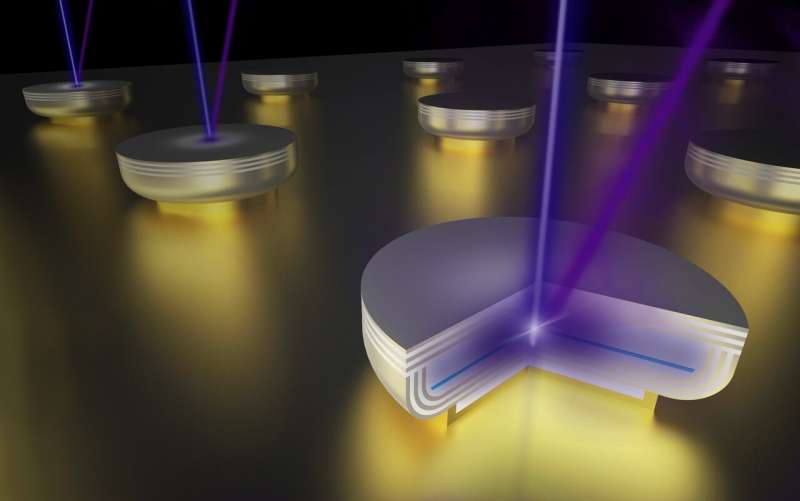World's shortest wavelength for a vertical-cavity surface-emitting laser demonstrated

Researchers at Chalmers University of Technology, with collaborators at Technische Universität Berlin, have demonstrated the shortest wavelength ever reported of a vertical-cavity surface-emitting laser (VCSEL). This can pave the way for future use in, for example, disinfection and medical treatment. The results were recently published in the scientific journal ACS Photonics.
"Although there is still much work to be done, especially to enable electrically driven devices, this demonstration provides an important building block for the realization of practical VCSELs covering the major part of the UV spectral range," says Filip Hjort, Ph.D. student at the Photonics Laboratory at MC2 and first author of the article.
A vertical-cavity surface-emitting lasers (VCSEL) is a compact semiconductor laser and has seen widespread application in, for example, facial recognition in smartphones and for optical communication in data centers. So far, these lasers are only available commercially with red and infrared wavelengths, but also other visible-emitting VCSELs, that could find applications in adaptive headlamps for cars or projection displays, will soon be commercialized.
"If the wavelength range could be pushed further, into the ultraviolet (UV), VCSELs could find any even broader use. UV light can be used for disinfection, material curing, fluorescence excitation, and medical treatment, and UV-emitting VCSEL could, for example, be used in compact water, air and surface disinfection systems as well as for treatment of skin diseases," says Filip Hjort.
To realize UV emission wavelengths in the ultraviolet B (280-320 nm) and ultraviolet C (200-280 nm), which is needed for most of these applications, the laser medium must be made of AlGaN. The research group of Åsa Haglund, Professor at the Photonics Laboratory at MC2, have previously, together with their collaborators at Technische Universität Berlin, demonstrated an electrochemical etching method that can be used to selectively etch specific AlGaN layers. In their current work, the two research groups use this method to create the world first optically pumped UVB-emitting VCSEL.
"By using the electrochemical etching technique to remove the substrate and create smooth AlGaN membranes, we solved a long-standing problem for UV VCSELs. VCSELs need two mirrors with over 99% reflectivity and these can either be made using epitaxial growth or dielectric materials. However, reflectivities that high in the UVB or UVC have not been achieved using epitaxial growth, and the typical substrate removal methods used to enable the deposition of the second dielectric mirror in blue-emitting VCSELs are not suitable for AlGaN," explains Hjort. "By employing electrochemical etching, we were able to create AlGaN membranes that we could sandwich between two highly reflective dielectric mirrors. In this way, we formed a vertical cavity that lases under optical pumping."
The new demonstration is the shortest wavelength VCSEL ever reported and the electrochemical etch technique is also extendable to UVC wavelengths which are needed for sterilization applications to, for example, combat future pandemics and provide clean drinking water.
More information: Filip Hjort et al. A 310 nm Optically Pumped AlGaN Vertical-Cavity Surface-Emitting Laser, ACS Photonics (2020). DOI: 10.1021/acsphotonics.0c01382
Journal information: ACS Photonics
Provided by Chalmers University of Technology



















